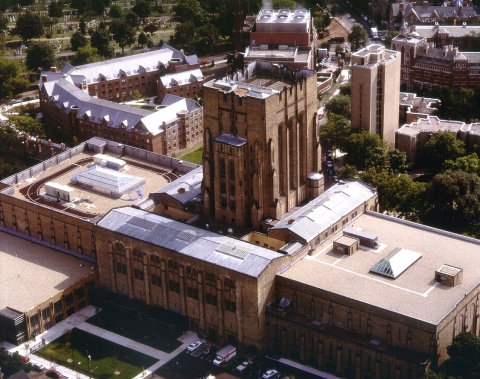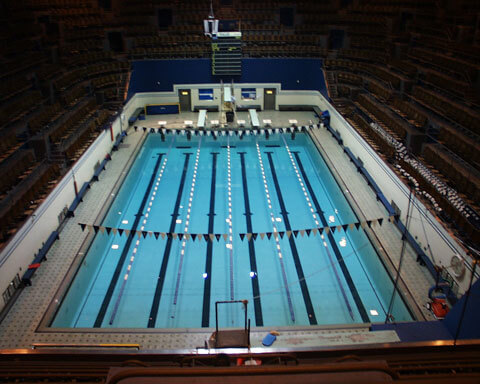Kiphuth’s Ride to the Medal of Freedom: Part VII; Building A Taj Mahal for Swimming
As seen through the eyes of Chuck Warner, Swimming World Contributor
NEW HAVEN, Connecticut, August 27. AS Bob Kiphuth drove across the border from Connecticut into New York on his way toward Washington D.C. for the ceremony with President Johnson, he might have thought back to his first Olympic experience at the 1928 Games hosted by The Netherlands in Amsterdam. There were many firsts at those Olympics. Thirty-four years had passed since that time and he had been right in the middle of many changes in the sport.
Only two cities bid on the 1928 Games, Los Angeles and Amsterdam. Among the “firsts” in Amsterdam that the coach bore witness to, was the adoption of a lighting of an Olympic flame, the institution of the current 16-day format, being called “The Summer Games” and the first sponsorship by Coca-Cola. The 6000-seat venue for the outdoor 50-meter concrete pool was a magnificent venue for the sport in its day.
Johnny Weissmuller was a star of the Games with his gold medal swims in the 100 freestyle and the 800 freestyle relay, the lone relay swum by the men. Weissmuller's personal coach, Bill Bacharach was the head men's coach and Coach Kiphuth was head coach for the women even though he had been a swimming coach for just 10 years.
The difference between Coach Bacharach and Coach Kiphuth was great. Bacharach had a pension for publicly smoking cigars and dressing in attire so casual that it might include his favorite bathrobe. In a workout situation, Kiphuth dressed in a loose gown, but when it was time to show the sport to the public he represented his country, his university and himself with immense pride and dignity. History (and Coach Peter Daland) has noted him as “the man that put a coat and tie on the swim coach.”
Weissmuller's movie career after the Olympics seemed a little farfetched since he had no formal acting training. His swimming success at the 1924 and 1928 Olympics might have earned him one role as Tarzan but it was his screen test with his co-star Maureen O'Sullivan, who played Jane, that lit up the studio and launched a 20-year movie career with more than two dozen movies. But Kiphuth was a showman too, and the sport of swimming was what he longed to showcase.
Just as the development of excellent alumni relations recently at schools like USC by Peter Daland and The Ohio State University nurtured by Coach Bill Wadley, Yale needed to find a major donor to build a new aquatic center. Kiphuth was a master of alumni development and his school needed a new gymnasium as well as a new swimming facility.
William Payne Whitney had graduated from Yale in 1898 and came from an extremely wealthy family. His inheritance included money from his father and $63,000,000 from his uncle, Col. Oliver Hazard Payne. While at Yale he had captained the rowing team. William Payne Whitney died in 1926 at the young age of 51. His son John Hay Whitney, of the Yale class of 1926 donated the money for the building of a new gym in honor of his father.
There is an unsubstantiated story told that John's mother wanted the family to donate a cathedral to Yale. But the school wanted and needed the gym. Ms. Whitney was getting old and the story goes that John instructed architect John Russell Pope to build the outside of the building to look like a Gothic cathedral. When it was completed the President of Yale drove Ms. Whitney by and she saw a cathedral, while Yale had a fabulous new athletic center.

Photo courtesy Yale Athletics
The building was constructed in the shape of an upside down capital “T” with a nine and a half story tower in the center and two five story wings on either side. When facing the front door, the wing on the right side housed varsity basketball, volleyball and gymnastics. The tower included 15 international regulations squash courts, handball courts, exercise rooms, basketball courts, 3 rowing tanks for crew, etc., etc. On the third floor of the tower was a five-lane 50-meter pool. To this day it is the largest suspended pool in the world. A bulkhead moved to divide it into 25-meter or 25-yard courses and one story above was an area for observation. An elevator swooped a swimmer five stories down to the competition pool.

Photo courtesy Yale Athletics
The wing on the left side housed the “Exhibition Pool” which was designed by Coach Kiphuth. It would play host during the next 50 years to numerous AAU Nationals and NCAA Championship competitions and much, much more. The 2187 seats rose on a 45 degree angle above the pool deck to create what may still be the greatest spectator swimming facility in the world.

Photo courtesy Yale Athletics
The visionary qualities that enabled Robert John Herman Kiphuth to so positively influence the sport of swimming between 1928 and 1962 when he received the Presidential Medal of Freedom, might well be demonstrated by some of the innovations that he conceived of for the Yale facility.
Competition pools had never had turning “crosses” at each end to help swimmers see the walls. Kiphuth had the construction crew at Yale put tile crosses at the end of each lane but he had them turn the tiles backward so the slippery side of each tile would be buried in the wall.
Kiphuth created two innovations to ensure a smoother, faster racing water surface. He noted that gutters had been built with a flat interior wall that water bounced back from and when the water was very turbulent during racing it wouldn't be absorbed effectively by the gutter system. He helped design a concave gutter so the water washed downward and was carried away and circulated through the filtration system. Up until this time, lane lines were made of ropes with buoys ever few feet to keep them a float. Kiphuth lined each rope with round cork to discourage washing water from one lane to the next and help prevent one swimmer dragging on the wave of another. Adding to the fast water was an all deep bottom.
In order to creating the best spectator seating pool in the world he did more than just place 2187 seats with unobstructed views of the racing course below. The spectators entered the amphitheater through tunnels and doors that ensured only 35 spectators would need to use each one and a guest would only have to traverse a maximum of three steps to find their row of seats. Kiphuth noted that pools were often hot, humid and uncomfortable for people to watch the sport so he had air exchangers put in that blew cold air under the seats and warm air out on the pool deck for the swimmers. The benches on the deck were also heated to comfort the swimmers.
When the building was completed in 1932 Yale had the most complete gymnasium in the world and its fastest 25 yard swimming facility. More than 20 long course/50-meter world records were set at Yale during the next 20 years, as well as dozens of American records and additional world records when they were recorded in distances in a 55 yard course. Through the 1930s and into the 1960s the Yale facility became the showcase swimming center in the world. The magical aquatic center was only the stage to create the play. The director was the imaginative Bob Kiphuth …we will explain what he did next time.
Credit for story help due for interviews by Terry Warner and Bruce Wigo with Phil Moriarty and Yale Archives.
Chuck Warner is contributor for Swimming World Magazine and author of Four Champions: One Gold Medal. Chuck's latest book titled And Then They Won Gold, is now available for purchase.
Kiphuth's Ride to the Medal of Freedom: Part I
Kiphuth's Ride to the Medal of Freedom: Part II
Kiphuth's Ride to the Medal of Freedom: Part III
Kiphuth's Ride to the Medal of Freedom: Part IV
Kiphuth's Ride to the Medal of Freedom: Part V
Kiphuth's Ride to the Medal of Freedom: Part VI



